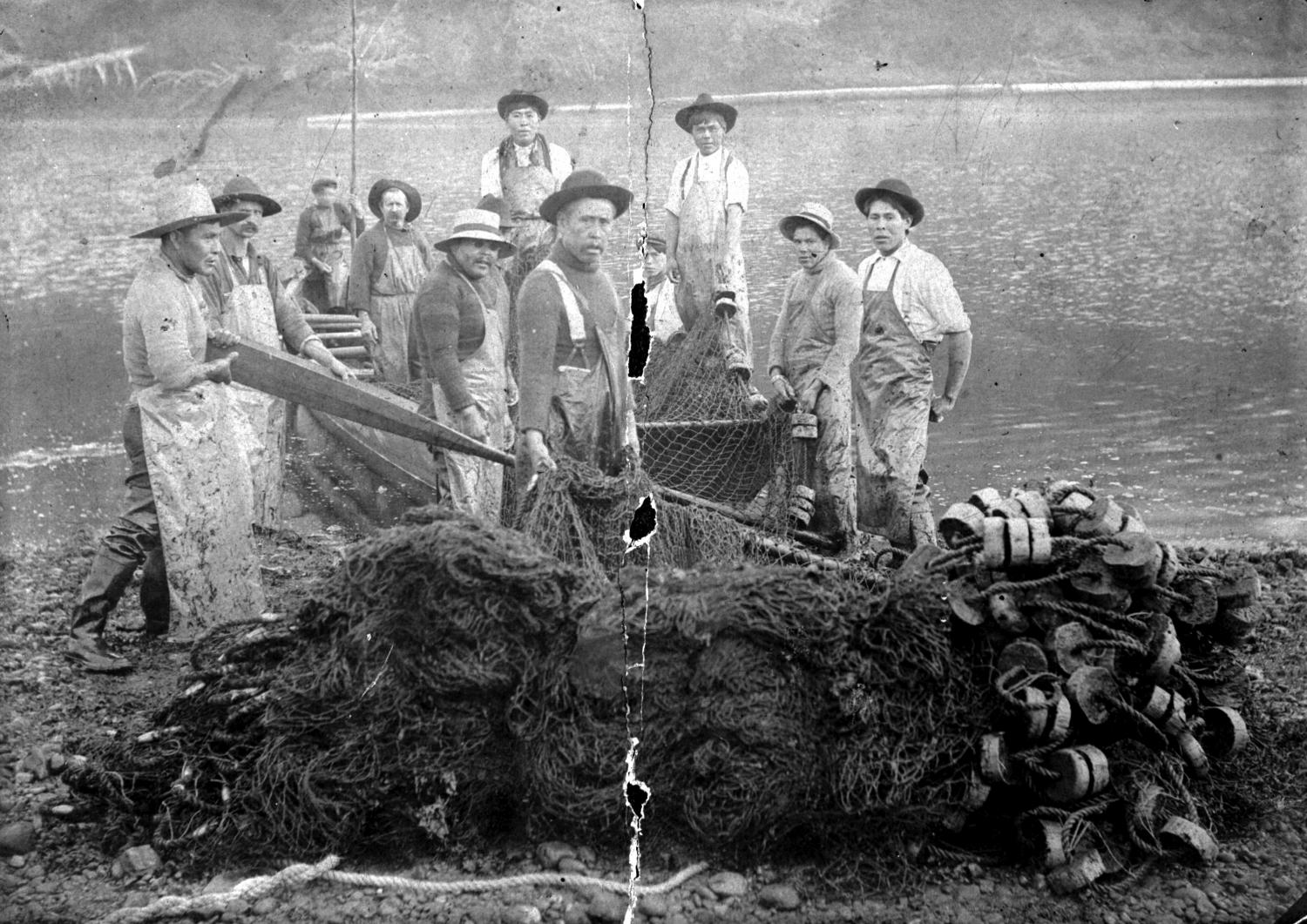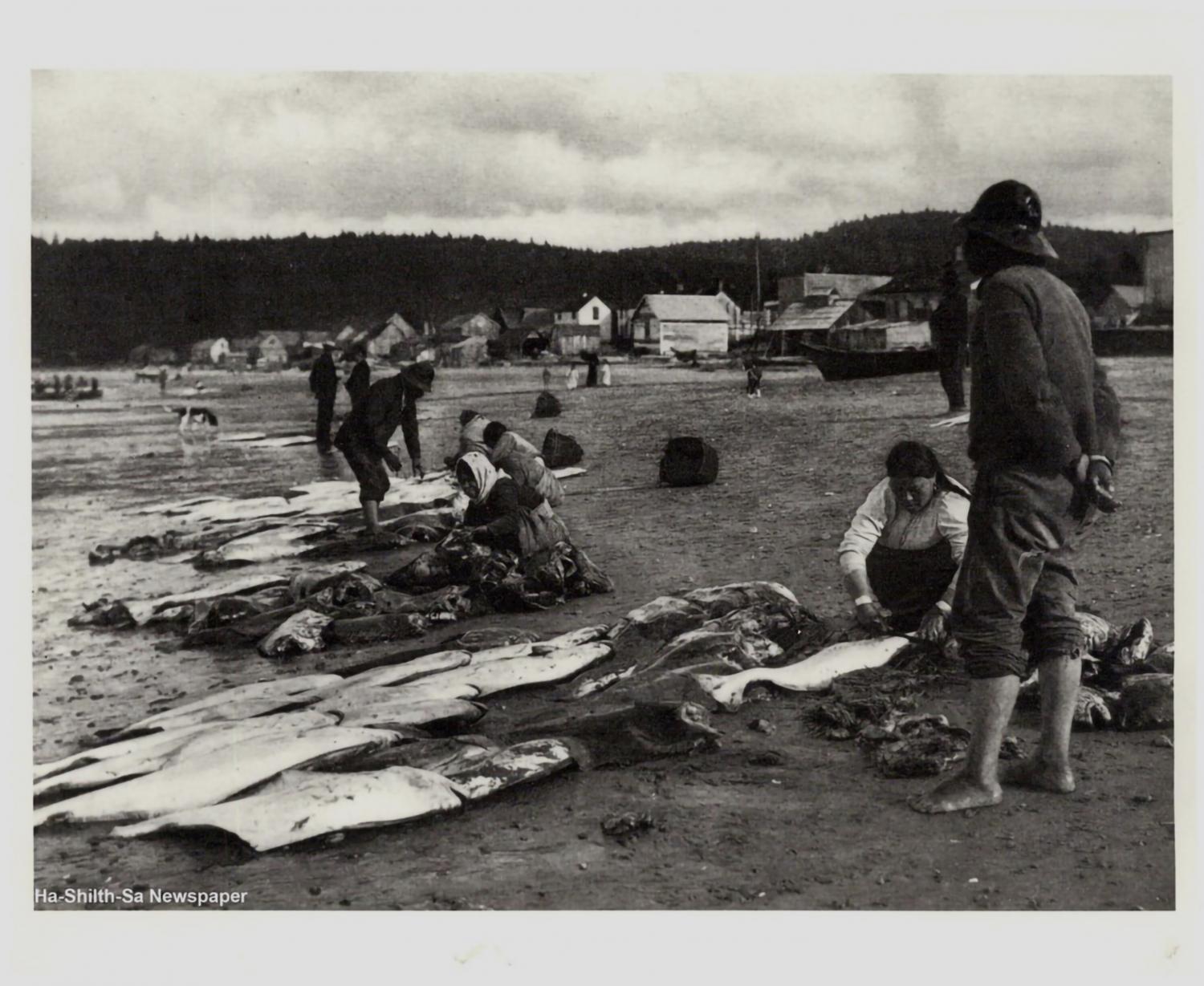Indigenous Lose Fishing Rights
New rules allow settler canneries to prosper at the expense of Indigenous fishers
Date: 1888
For millennia, salmon have provided valuable sustenance to First Nations in British Columbia. In return, Indigenous communities treat the fish with outsize respect. Every year, many interpret the returning salmon as bygone relatives bearing gifts. But this high regard extends beyond spiritual beliefs. Though Indigenous communities historically harvested tremendous amounts of fish, they were careful to do so sustainably, wary of depleting the precious resource. European settlers would not only ignore this ecologically-minded approach but disrupt a way of life Indigenous communities had long enjoyed.
Before colonization, the Stó:lō people likely numbered somewhere between 20,000 and 60,000. Living along the lower Fraser River, the Stó:lō consumed as many as 12 million salmon annually, excluding fish used in ceremonies or for trade. And yet, the local salmon continued to return in abundance.
“There is no law governing fish in British Columbia,” wrote H.L. Langevin, federal minister of public works, shortly after B.C. joined Canada. “Fishing is carried on throughout the year without any restrictions.” But he was wrong. The Stó:lō and other First Nations in B.C. maintained healthy salmon stocks by implementing clearly defined rules specifying who could fish, how many fish could be caught, and so on. Typically, hereditary leaders with ancestral rights to fishing spots acted as stewards, responsible for allocating the resource equitably. Those who held this power risked their own rank and prestige if they abused it. Potlatches often served as a means to monitor fishing habits and practices.
The British initially recognized some Indigenous fishing rights. The so-called Douglas Treaties of the 1850s allowed Indigenous signatories to maintain their fisheries as they had “formerly.” But Indigenous fishing rights soon receded in the wake of B.C.’s cannery industry, which began in the 1870s. Following pressure from canneries, governments introduced regulations that curtailed Indigenous access to fisheries — paving the way for a wildly lucrative commercial fishing industry that overwhelmingly profited settlers.
In 1888, the federal government prohibited Indigenous from using time-tested equipment, like drift and scoop nets, unless they received permission. Crucially, that year also saw Ottawa confine Indigenous fishers, who had long traded their catch with neighbouring tribes or European fur traders, to fishing only for sustenance — often called the “Indian” food fishery. This move meant they could only work as low-paid labourers in B.C.’s now-booming cannery industry. At the same time, governments were also whittling down reserve lands in British Columbia, and many Indigenous communities found themselves further isolated from their traditional fishing spots.
More discriminatory regulations followed, increasingly severing Indigenous from the fisheries they and their ancestors had relied upon. By 1894, Indigenous fishermen had to obtain a licence just to fish for food. The “Indian” food fishery was a fundamental way of keeping Indigenous people at the periphery of the prosperous commercial fishing industry that had taken hold on the West Coast. The food fishery would later be described as a “valuable privilege” by Charles Tupper, Canada’s short-lived sixth prime minister: “Such permission is not to be considered as a right but as an act of grace, which may be withdrawn at any time.”
Though changes have occurred, the Aboriginal food fishery still holds a foundational place in Canada’s fishing regulations. As a result, Indigenous fishers across the country are still fighting for their Aboriginal right to fish while, at times, facing violent confrontations with non-Indigenous fishers.
Sources:
1. Aboriginal Fisheries in British Columbia. First Nations & Indigenous Studies at the University of British Columbia, indigenousfoundations.arts.ubc.ca/aboriginal_fisheries_in_british_columbia/.
2. First Nations Fishing Rights - Fact Sheet. Assembly of First Nations, 18 May 2018, www.afn.ca/first-nations-fishing-rights-fact-sheet/.
3. “Fisheries and Fishing Rights.” Stolen Lands, Broken Promises: Researching the Indian Land Question in British Columbia, Union of BC Indian Chiefs, 2005, d3n8a8pro7vhmx.cloudfront.net/ubcic/pages/145/attachments/original/1508270022/CH13_Fisheries_and_Fishing_Rights.pdf?1508270022.
4. Fishing. BC Treaty Commission, www.bctreaty.ca/fishing.
5. Forester, Brett. The Delgamuukw Decision: Putting the Wet'suwet'en Conflict in Perspective. APTN News, 4 Mar. 2020, www.aptnnews.ca/national-news/the-delgamuukw-decision-putting-the-wetsuweten-conflict-in-perspective/.
6. Harris, Douglas C. Aboriginal Rights to Fish in British Columbia. The Scow Institute, 2007, scow-archive.libraries.coop/library/documents/Aboriginal_Fishing_Rights.pdf.
7. Harris, Douglas C. “Introduction.” Landing Native Fisheries: Indian Reserves and Fishing Rights in British Columbia, 1849-1925, The Peter A. Allard School of Law at the University of British Columbia, 2008, commons.allard.ubc.ca/cgi/viewcontent.cgi?article=1189&=&context=fac_pubs&=&sei-redir=1&referer=https%253A%252F%252Fwww.google.com%252Furl%253Fq%253Dhttps%253A%252F%252Fcommons.allard.ubc.ca%252Fcgi%252Fviewcontent.cgi%253Farticle%25253D1189%252526context%25253Dfac_pubs%2526sa%253DD%2526source%253Deditors%2526ust%253D1619058461650000%2526usg%253DAOvVaw1qitO-3Tqgx1JujT5LSvAw#search=%22https%3A%2F%2Fcommons.allard.ubc.ca%2Fcgi%2Fviewcontent.cgi%3Farticle%3D1189%26context%3Dfac_pubs%22.
8. Harris, Douglas C. The Legal Capture of British Columbia's Fisheries: a Study of Law and Colonialism. University of British Columbia Open Collections, June 1998, open.library.ubc.ca/cIRcle/collections/ubctheses/831/items/1.0077430#downloadfiles.
9. Kopas, Leslie Clifford. Political Action of the Indians of British Columbia. University of British Columbia Open Collections, Apr. 1972, open.library.ubc.ca/handle/2429/33442.
10. Meloney, Nic. Mi'kmaq Tackle Decades-Old Standstill on Fishing Rights with Historic, Self-Regulated Lobster Fishery. CBC News, 19 Sept. 2020, www.cbc.ca/news/indigenous/mi-kmaq-self-regulated-moderate-livelihood-fishery-1.5727622.
11. Minke-Martin, Vanessa. The Long, Expensive Fight for First Nations' Fishing Rights. Hakai Magazine, 23 Oct. 2020, www.hakaimagazine.com/news/the-long-expensive-fight-for-first-nations-fishing-rights/.
12. Tough, Frank. Review of Landing Native Fisheries: Indian Reserves and Fishing Rights in British Columbia, 1849- 1925 by Doulas C. Harris. BC Studies, 4 Nov. 2013, bcstudies.com/book_film_review/landing-native-fisheries-indian-reserves-and-fishing-rights-in-british-columbia-1849-1925/.
13. Wonders, Karen. Indian Land. First Nations: Land Rights and Environmentalism in British Columbia, www.firstnations.de/indian_land.htm.





